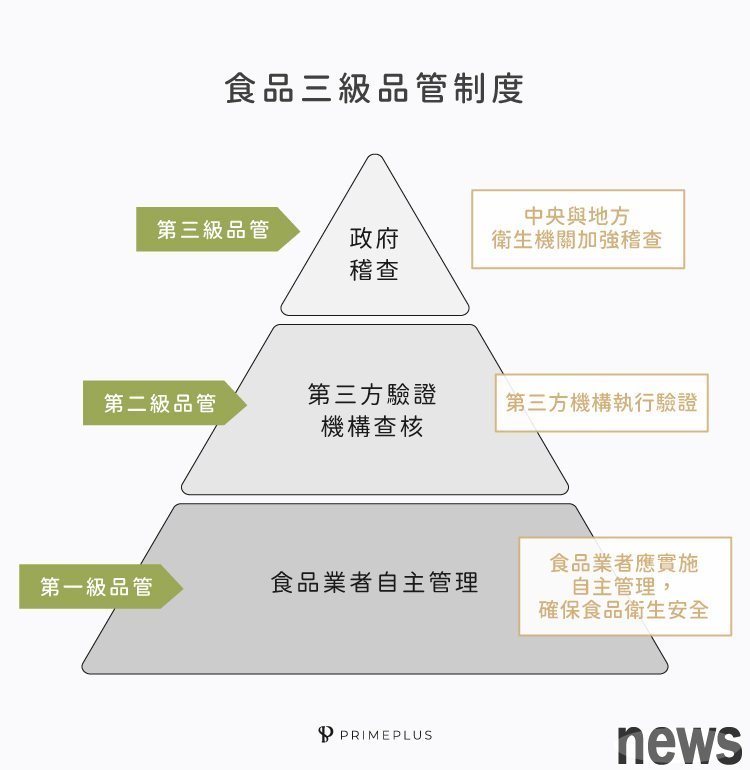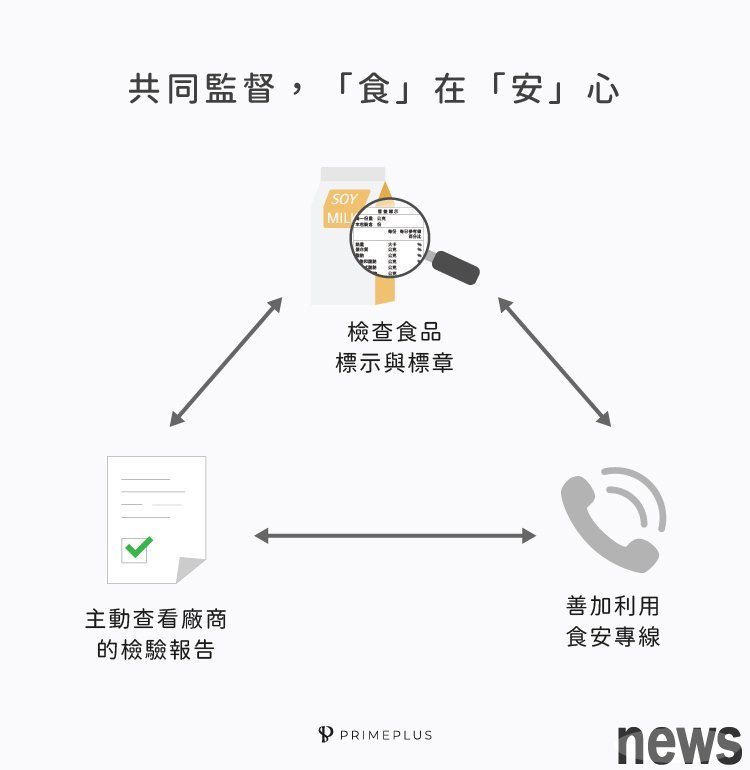
The recent ethylene oxide incident has occupied major news pages, making everyone panic when they hear "ethylene oxide". It is a chemical raw material and can also be used as the disinfection of medical equipment. In some countries, it will be used to disinfect crops. However, my country's regulations on ethylene oxide are "not allowed to be used as agricultural medicine, nor should it be detected in food." Therefore, when imported foods are detected to be retention of ethylene oxide, they must be returned or sold. As a first-class carcinogen, it will damage kidney function and increase carcinogenic risks under long-term contact. Through this incident, we can know that food safety is closely related to our lives, and it is extremely important to establish a complete quality control system. Today, let [PrimePlus Health Designer] brand nutritionists come to learn about our country's "Food Safety Third Quality Control System"!
The origin of third-level food quality control isThe Food Safety Hygiene Management Law (simplified food safety law) was revised in 2014 to establish a third-level food safety quality control system. In accordance with Articles 7, 8 and 41 of the Food Safety Law, food operators are enforced to implement third-level quality control, namely, three levels: independent management of operators, third-party organization verification, and government audit evaluation to strengthen food safety. The content in the following paragraph will bring you to know the content and details of Level 3 Quality Control, and see how food operators and the government focus on everyone's daily diet safety!
{9 Level 1 quality control: Employers manage independently. If you often go to restaurants or hand-held cup shops, you can pay more attention to whether there are any test reports on the wall or counter, such as ice germs, fried oil quality inspections, etc. Other commonly heard test items such as food heavy metal, agricultural medicine, microbial test, etc. are all subject to first-class quality control. The contents of first-level quality control include performing product forced inspections, such as regular inspections of raw materials, semi-finished products and finished products; and stipulate that employees formulate food safety monitoring plans on their own, and conduct independent management of product quality in accordance with hazard analysis and risk assessment; at the same time, food operators will also be required to set up test rooms to check the quality of their own products at the same time.‧ Second-level quality control: third-party agency verification "This food factory has passed the HACCP and GHP verification!" We often see such descriptions. According to the government announcement, when a specific type of food business reaches a certain scale, the government will forcefully require the operator to obtain a second-level quality control verification, that is, a third-party verification agency certified by the Ministry of Welfare will go to the factory for actual verification to verify whether the factory's management of personnel, factory areas, food processes, and quality assurance systems comply with the regulations to maintain the safety of people's diet and health.
‧ Level III quality control: The government inspected and inspected the recent attention-defying ethylene oxide retention incident and the hepatitis A virus incident in berries, which were discovered by the hydrant when the product was inspected. According to Article 41 of the Food Safety Law, the government has the right to check and inspect raw materials, products, factories, utensils, additives, etc. of food operators, and operators shall not avoid or refuse. Therefore, a system like this that is inspected and inspected by government units and is classified as the third-level quality control.

Joint supervision, "food" is in peace of mind
If you want to improve the environment and quality of food safety in all aspects, you cannot rely solely on the government and the practitioners! As consumers, we are also responsible for maintaining our dietary safety together. The specific method can be completed through the following three points:
1. The first step to carefully checking food marks and marks to maintain food safety is to start by understanding food marks! Packaged food labels should be stated in accordance with the Food Safety Law on the product name, content, validity date, origin, manufacturer name and verification stamp and other important information. In addition to ensuring that your rights are not impaired, you can also trace the food you bought from using the marked information.
2. Actively view the inspection report and quality control form presented by the merchant. When eating or buying products in restaurants or beverage stores, you can check whether the operator has presented the inspection report or quality management form, so as to check whether the operator has the principle of first-level quality control and implement the principle of independent management. You can also know what inspection and management the owner has done for the product in the report to ensure their rights to know about the safety of diet and health.
3. Good use of food safety specialty. In recent years, the government has started the "1919 Food Safety Specialty Specialty" due to the discussion on food safety issues, which symbolizes the determination of government agencies to work together with the public to protect food safety. As long as the public has food-related problems, such as black-hearted food inspection, food consultation, consumption problems, and fresh agricultural consultation, they can serve you by calling the 1919 Food Safety Specialty Specialty.

Being pursuing the advancement of modern technology, the development of the food industry has become more and more fashionable. There are various types of foods available to us on the market for us to choose. Through food nutrition knowledge articles, we can improve consumers' food safety awareness and correctly choose safe and secure products. This is also the direction [PrimePlus Health Designer] has been working hard. After reading today's article, I believe you will definitely become a qualified food safety expert and work hard on our "food" matters together!
This article is authorized by the "Health Knowledge Plus Column", and reprinting is prohibited without consent Responsible editor: Chen Yaomei